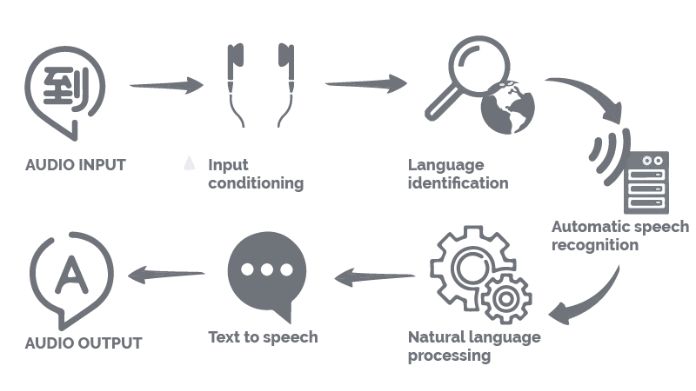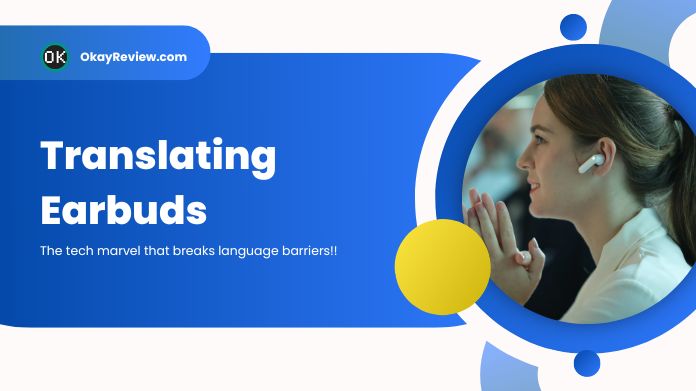Are you curious about the latest technological marvel that breaks language barriers effortlessly? Look no further than Translating Earbuds!
These brilliant tiny gadgets have taken the world by storm, offering flawless communication in any language.
In this helpful Okayreview Guide, we’ll delve into the exciting world of Translating Earbuds and explore the mystery of how they work.
Translating Earbuds are more than just headphones; they can translate languages quickly, making interactions with individuals from diverse cultures a snap.
But how do they do their miracles? Join us as we investigate the fantastic technology that powers these earphones, allowing for instant real-time translation of conversations.
Let’s dive in and uncover the magic behind Translating Earbuds together!
Table of Contents
What is Translating Earbuds?
Earbuds that can translate bring science fiction’s universal translator notion closer to reality.
These wireless gadgets provide real-time language translation by combining headphones with a smartphone app. The earphones function as audio output terminals, while the app handles translation.
You may easily converse with others in different languages by connecting your smartphone via Bluetooth.
There’s no need to enter or touch your phone since these in-ear translators provide a smooth and straightforward translation experience.
It’s like having your personal language assistant in your ears, making cross-language conversation straightforward and uncomplicated.
How Do Translating Earbuds Work?
 A new trend in the market is the translating earbuds, which can translate any language.
A new trend in the market is the translating earbuds, which can translate any language.
People have different opinions about them; some say they are good, and others are not.
But how do these earbuds work to provide accurate and real-time translation? Well, the in-ear translator follows five procedures to process translation data.
1. Conditional Input
Best-Selling Two-Way Translation Conditional input is used in earbuds to ensure proper translations.
They record user speech and noise, activate in response to vocal activity, and denoise to remove background noise.
Touch control improves the accuracy of the Voice Activity Detector (VAD). These earphones filter out surrounding noise while prioritizing the user’s speech to ensure correct translations.
When linked to a phone running the translate app, they quickly isolate and translate the relevant phrases from the background noise.
For the most fantastic experience, use an in-ear translator with powerful noise cancellation/filtering.
2. Language Identification
Machine learning is used in language identification to discern the spoken language swiftly.
Phonetics alone cannot distinguish between languages such as Urdu and Hindi or Ukrainian and Russian, which share similar “phoneme” units.
For accurate categorization, new auditory representations are required.
3. Recognizing Speech Automatically
An acoustic prototype converts recorded voices into phonemes and language modeling, then transforms them into words.
Networks fill in the blanks in data, correct mistakes, and infer written articulation.
In-ear translators quickly convert recorded words into text, recognizing language, breaking terms down into phonemes, and adjusting accents and pronunciations.
4. Processing Natural Language
Natural language processing enables computer translation across several languages, capturing subtleties and complexity.
The powerful AI-powered in-ear translator goes beyond word-by-word translation, considering context and emotion for accurate results.
It produces exact and meaningful translations using a language database and machine learning, allowing for seamless communication across language boundaries.
5. Text-to-speech Software or Speech Synthesis (TTS)
Text-to-speech software, called speech synthesis, translates written text into a natural-sounding voice.
To make a speech in the past, additive synthesis involves merging short recordings of multiple phonemes. To imitate lifelike sounds, sophisticated statistical speech prototypes are being employed.
Following translation, the in-ear translator swiftly moves on to voice synthesis, converting the translated words into audio output that sounds as natural as feasible.
The computer replicates perfect pronunciation and intonation based on recorded phrases, giving precise, real-time translations via portable headphones.
What Are the Limitations of Translating Earbuds Technology?
1. Disparity in Language Database
The discrepancy in language databases impedes the universality of in-ear translators.
They can only recognize roughly 100 languages, but several popular brands acknowledge only 40-60 languages.
Due to restricted datasets, low-resource languages are eliminated, reducing translation accuracy.
2. Insufficiency in Emotional
Machine translation must be improved when dealing with human emotions, cultural subtleties, and context-based language.
In-ear translation technology based on AI needs to improve human translation regarding emotional intelligence and cultural sensitivity.
To provide additional value advances in context comprehension and cultural transmission are required.
3. Only Works One-way
In-ear translators are one-way only; hence two-way communication requires passing the translator.
Despite significant drawbacks, the technique is promising, providing high-accuracy real-time translation in common languages. It’s worth a shot!
Wrapping Up!
The language revolution we’ve been waiting for has arrived in the form of translating earphones!
These ingenious technologies provide seamless communication wherever you go, breaking down linguistic barriers.
So, the next time you travel or meet someone from another country, make translating earphones your perfect language buddy.
Embrace the power of connection, and the world becomes your playground!
Happy Communicating!
Frequently Asked Questions
Q. How Accurate Are Translating Earbuds?
Ans. Translating Earbuds is not 100% exact; they are quick but not precise. It is culturally insensitive and unable to contextualize meaning.
As a result, idioms and metaphors need to be more frequently understood. Linguistic correctness is critical for any company selling a product or providing a service in a foreign market.
Q. What is the Purpose of a Translator Device?
Ans. The entire purpose of a language translation gadget is to assist you in overcoming language hurdles on-site.
Because 40% of the world only speaks one language fluently, linguistic variations inevitably impair productivity and overall business operations when businesses grow abroad.

